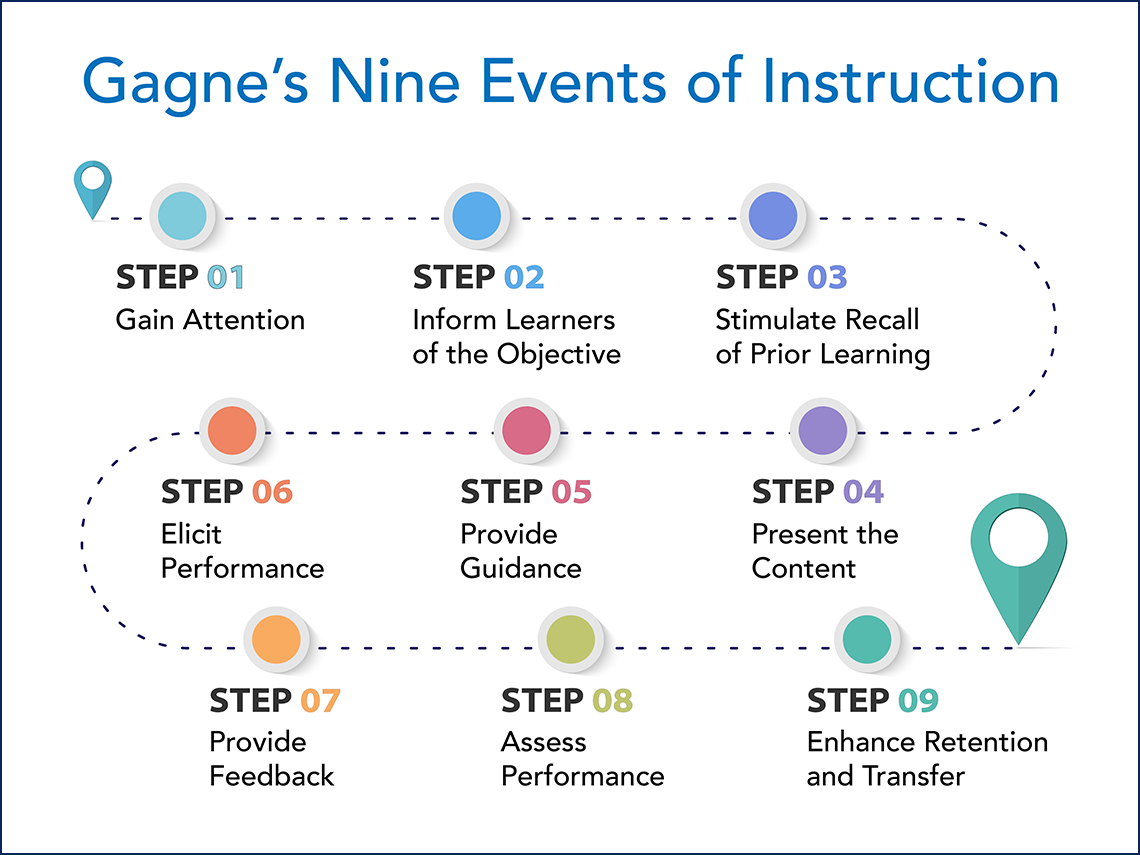
Credit: © Penn State is licensed under CC BY-NC-SA 4.0
Gagné's Nine Events of Instruction is a comprehensive instructional design model developed by Robert Gagné in the 1960s. It outlines a set of events, or steps, that instructors can follow to create effective learning experiences for students. The model is based on the idea that different types of learning objectives require different types of instruction. Remember, the key is to tailor the method of each event to the specific context and audience. The goal is to motivate learners to continue to focus as the lesson progresses through each of the nine events of the learning experience.
The following example shows how Gagne's Nine Events of Instruction can be applied to teach students about the difference between weather and climate. Let's go through each event in the context of this lesson:
Event 1. Gain Attention
Begin the lesson with a striking image or a brief engaging statement related to weather and climate. For example, you could start with a captivating image of changing seasons or by describing a dramatic weather event like a hurricane. Some other ideas for grabbing students' attention include:
- Playing a humorous video clip.
- Telling an emotional story.
- Presenting a difficult challenge.
- Asking a thought-provoking question.
- Using a prop.
Event 2. Inform Learners of the Objective
Clearly state the learning objective: "By the end of this lesson, you will be able to distinguish between weather and climate, understanding their definitions and how they differ.”
Event 3. Stimulate Recall of Prior Learning
Ask students to recall their previous knowledge about weather and climate. Prompt them with reflection questions like, "What comes to mind when you think of weather?" and "How would you define climate?" Additional ways to stimulate recall of prior learning are to:
- Ask students to draw a concept map.
- Give a no-stakes quiz or create a game for the same purpose.
- Ask students to write everything they remember about the topic for one minute.
- Give students a partially completed outline and ask them to fill in what they can.
Event 4. Present the Content
Provide a clear explanation of the concepts of weather and climate and the differences between them. Use visuals, diagrams, animations, and real-world examples and phenomena that students can relate to. Emphasize key terms and characteristics associated with each concept.
Event 5. Provide Guidance
Offer guidance on how to differentiate between weather and climate. Share specific criteria or features that distinguish the two, such as timescale, variability, and the types of phenomena they encompass. Some additional ways to provide guidance are to:
- Use modeling to demonstrate how to do something.
- Create conceptual maps to help students structure info and see connections.
- Include guided practice exercises.
- Provide students with feedback on their work regularly.
- Create knowledge checkpoints to help students gauge understanding.
- Provide rubrics for assignments and assessments.
Event 6. Elicit Performance
Engage students in an activity where they can demonstrate their understanding. This could involve analyzing weather data, describing climate patterns, or participating in a discussion about the practical implications of distinguishing between weather and climate. There are lots of creative ways to elicit performance including:
- Hands-on activities or experiments.
- Role-playing scenarios, simulations, or case studies.
- Collaborative group projects.
- Individual or group problem-solving exercises.
- Portfolios that showcase student work.
Event 7. Provide Feedback
Offer immediate feedback on the performance task. Clarify any misconceptions and highlight correct responses. Encourage questions and further discussion to deepen understanding. Other ways to provide feedback include:
- Grading rubrics
- Annotations
- Peer reviews
- Self-assessment
Event 8. Assess Performance
Administer a brief quiz or assignment to assess students' comprehension of the differences between weather and climate. This could include scenario-based questions or real-world applications. Assessing performance can also be done by asking students to:
- Create a concept map.
- Participate in discussions.
- Make a presentation.
- Complete a lab exercise.
- Do a demonstration.
- Write code.
Event 9. Enhance Retention and Transfer
Conclude the lesson by relating the concepts to real-world examples or current events. Discuss how understanding weather and climate is relevant to broader issues like climate change. Encourage students to reflect on how they can apply this knowledge in different contexts. Other ways to enhance retention and transfer include:
- Asking students to teach each other.
- Give students a case study and ask them to work together to solve it.
- Ask students to imagine what would happen if one of the things they just learned was different.
- Group students, give them a problem, and ask them to solve it.
- Ask students to think of ways that what they learned may apply to other situations.
Considerations
Use alt tags for images, caption all videos, and create multimedia and interactive elements using accessibility best-practices.